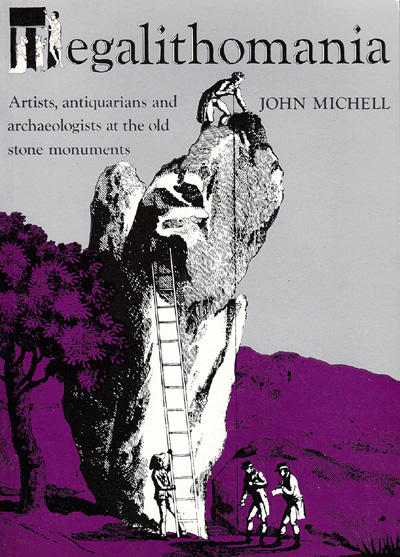Stone Mad | Megalithomania Review by Tony O'Riordan
 Megalithomania by John Michell published by Thames and Hudson. Review by Tony O'Riordan pubished in The Irish Times, 9 April 1982
Megalithomania by John Michell published by Thames and Hudson. Review by Tony O'Riordan pubished in The Irish Times, 9 April 1982
Professor Magnusson the Icelandic scholar and Runic expert, acquired critical acclaim when he translated the inscriptions etched on the Runamo rock in Sweden. He spent a summer with an expedition, financed by the Danish Royal Society, making careful copies of the inscribed characters and claimed that they consisted of five poems written to celebrate the victory of Harold Hildetand over Sigurd King. He enjoyed a sensational triumph, but Swedish geologists quickly proved beyond any doubt that script was made up of natural lines and cracks in the rock surface.
This is one of the prime examples in John Michell's splendidly entertaining book about the cracked notions of those whom he feels were affected by "megalithomania". Among the tales he records is that of tales he records is that of Henry O'Brien, the Irish speaker who tried to prove that the round Towers were built by Persian immigrants as fire temples in connection with serpent worship and a phallic cult (he "died disappointed at the age of twenty-seven").
"The Engineer in Ordinary" in Ireland, General Charles Vallancey (a most interesting man, by the way who lived to be over 90) proved that Newgrange was built by the Chaldaeans, Indians or Africans or by the Persians as a Mithraic, temple and traced the connection between the Irish and Sanskrit languages the local eccentric, Lord Netterville built a tea-house on top of Dowth tumulus.
Moving away from Irish eccentrics he recalls Henry Brown, who thought that the serious state of the south-west of Stonehenge was due to the action of Noah's flood. No wonder that Dr. Glyn Daniel wrote in "Antiquity". "The problem in archaeology is when to stop laughing." John Aubrey's friend John Ray told that the father of English archaeology: "You are a little inclinable to credit strange relations." These two sayings should be in the satchel of every budding archaeologist, and it would be no harm to have this book in it as well.
There is a splendid account of archaeological illustrations and dolmen painters, with well-chosen illustrations. Constable was among the painters of prehistoric sites; his strange watercolour of 1835 is "the most famous of all Stonehenge paintings" (Louis Hawes wrote a fine monograph on this in 1975. Turner painted "two highly atmospheric views of the stones at sunrise and sunset, followed by his extraordinary scene of an elemental upheaval around Stonehenge." A.E.'s painting of a dolmen with music figure and swirling energy patterns is equally dramatic.
Michell refers rightly to the "high standards of antiquarian illustration in Ireland." These were set by Thomas Wright, author of the Louthiana" in 1748 and by Gerald Beranger. Another 18th century artist was Thomas Wright, who in mid-century drew a "Sepulchral Mound near Temple Patrick in the Country of Antrim." I have never been able to see a sign of it in that lovely place; does anyone know about it? Before that William Jones had made drawings of Newgrange and the 19th century was to give us Henry O'Neill, George Petrie, W.F. Wakeman, J. Windere of Cork and J.H.Burgess of Ulster: John Michell refers to "Many other (Irish artists) whose works are unpublished. There must be a final mention of Caspar David Friedrich, the early 19th century German Romantic, among whose paintings are "the most awesome of all megalithic images.
Purchase Megalithomania at Amazon.com or Amazon.co.uk
Boyne Valley Private Day Tour
 Immerse yourself in the rich heritage and culture of the Boyne Valley with our full-day private tours.
Visit Newgrange World Heritage site, explore the Hill of Slane, where Saint Patrick famously lit the Paschal fire.
Discover the Hill of Tara, the ancient seat of power for the High Kings of Ireland.
Book Now
Immerse yourself in the rich heritage and culture of the Boyne Valley with our full-day private tours.
Visit Newgrange World Heritage site, explore the Hill of Slane, where Saint Patrick famously lit the Paschal fire.
Discover the Hill of Tara, the ancient seat of power for the High Kings of Ireland.
Book Now
Home
| Visitor Centre
| Tours
| Winter Solstice
| Solstice Lottery
| Images
| Local Area
| News
| Knowth
| Dowth
| Articles
| Art
| Books
| Directions
| Accommodation
| Contact

